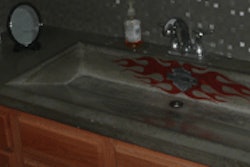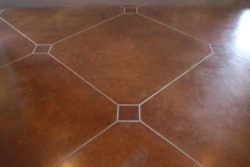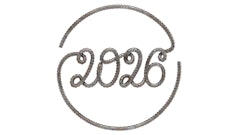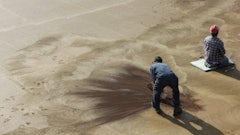
In September 2010, Don Wagner, owner of Concrete Worxs LLC, Boonville, Ind., and three of his employees took on the task of acid staining a new restaurant floor in Evansville, Ind. Concrete Worxs, which Wagner started three years ago, does mainly residential decorative concrete but decided to take on the challenge of the commercial staining project.
The decorative staining job was a new construction concrete slab and required 6,000 square feet of acid staining. A different concrete contractor was in charge of pouring the restaurant floor, Wagner says. To pre-empt any possible issues, Wagner explained to the client that working with acid stains throughout a four-month project could result in color variations in the final floor. He also walked the client over the slab to point out any areas of the concrete where the pour or drying might affect the staining and what the customer should expect in those areas.
Once the floor was poured and was ready for staining, Wagner and his crew worked around other trades on the jobsite. They worked nights and weekends to minimize congestion and interference between trades. The original plan called for the floor to be acid stained prior to putting up the drywall. However, changes during the course of the project only allowed Concrete Worxs to stain about half of the floor before drywall went up. The concrete had to be cleaned prior to starting work each night to eliminate debris that could potentially affect or prevent the acid stain from reacting, including excess drywall mud. The drywall mud had to be completely removed from the concrete prior to staining -- in some cases sanding was required to remove residue from the pores of the concrete surface.
The design of the floor was a checker board pattern. Wagner created custom stencil patterns using cardboard and tape. Saw cut designs and patterns were laid out using chalk line and cut with a 4-inch handheld grinder to create an aesthetic masterpiece.
The use of four different acid stain colors made color variations transparent while creating a flow of extensive patterns from room to room throuhout the restaurant. Staining started with a Scarlet Red from Surface Koatings, Inc. Wagner stained every other hand-cut tile using a 4-inch chip brush to apply the stain by hand. "When you apply with a brush you don't get as much residue," Wagner says. "So we only had to apply one good coat of stain." Once the red stain was complete, he came back and applied an Increte Mission Tan stain to the alternating tiles to achieve the checker board pattern. Concrete Worxs also created a unique accent in the restaurant's bar area creating a bordered, cobblestone sidewalk pattern using a variation of three stain colors on the floor. Once the acid reaction was complete, Wagner and crew washed the floor twice with water. They washed it a third time using baking soda and water to balance the slab's pH, Wagner says.
To seal the stained floor, Wagner used Euclid Diamond Hard penetrating sealer. "The Diamond Hard is tougher for scuffing and scratching," Wagner says. "And because it's a penetrating sealer it doesn't turn the stained concrete as dark as other sealers might." Wagner used push brooms and squeegees to apply one coat of the sealer. Another crew member followed with a shop vac to suck up any excess sealer. Finally, two coats of diluted wax (diluted 50/50 with water) were applied to even out the appearance. Crews then polished the floor with a high speed buffer and finishing pad, Wagner adds.
The project was completed in four months, a rather short time frame for a new construction project like this, Wagner says. Concrete Worxs had to meet the challenges of a tight time frame, on-the-job changes and working around other crews without compromising its quality of work. Wagner says the crew, with the help of its supplier Irving Materials Inc., did just that. The restaurant is a showcase to the versatility and creativity acid staining can bring to your concrete floor slab, he adds.




















